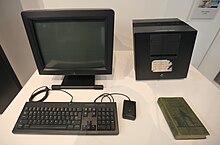NeXTcube
This article needs additional citations for verification. (March 2024) |
 The base NeXTcube model | |
| Developer | NeXT |
|---|---|
| Manufacturer | NeXT in Fremont, California |
| Type | Workstation |
| Release date | September 18, 1990 |
| Introductory price | US$7,995 (equivalent to about $19,000 in 2023) |
| Discontinued | 1993 |
| Operating system | NeXTSTEP, OPENSTEP, NetBSD (limited support) |
| CPU | Motorola 68040 @ 25 MHz, 56001 digital signal processor (DSP) |
| Memory | 8–64 MB |
| Storage | 400 MB, 1.4 GB, or 2.8 GB hard drive 2.88 MB floppy drive |
| Display | 1120×832 2-bpp grayscale |
| Connectivity | Ethernet |
| Dimensions | 1-foot (305 mm) die-cast magnesium cube-shaped case |
| Predecessor | NeXT Computer |
| Successor | NeXTcube Turbo |
The NeXTcube is a high-end workstation computer developed, manufactured, and sold by NeXT from 1990 to 1993. It superseded the original NeXT Computer workstation and is housed in a similar cube-shaped magnesium enclosure, designed by frog design. The workstation runs the NeXTSTEP operating system and was launched with a $7,995 (equivalent to about $19,000 in 2023) list price.[1]
Hardware
[edit]The NeXTcube is the successor to the original NeXT Computer, with a 68040 processor, a hard disk in place of the magneto-optical drive, and a floppy disk drive. NeXT offered a 68040 system board upgrade (and NeXTSTEP 2.0) for US$1,495 (equivalent to $3,490 in 2023). A 33 MHz NeXTcube Turbo was later produced.
NeXT released the NeXTdimension for the NeXTcube, a circuit board based on an Intel i860 processor, which offers 32-bit PostScript color display and video-sampling features.
The Pyro accelerator board replaces the standard 25 MHz processor with a 50 MHz one.[2][3]
Specifications
[edit]

- Display: 1120×832 17 in (432 mm) 82 ppi grayscale MegaPixel Display
- Operating system: NeXTSTEP 2.2 Extended or later
- CPU: 25 MHz 68040 with integrated floating-point unit
- Digital signal processor: 25 MHz Motorola DSP56001
- RAM: 8 MB, expandable to 64 MB (Sixteen 30-pin SIMM slots)
- Floppy drive: 2.88 MB
- Hard drive: 105 MB, 340 MB, 400 MB, 660 MB, 1.4 GB or 2.8 GB SCSI drive
- Network interface: 10BASE-T and 10BASE2 Ethernet
- Expansion: four NeXTbus slots (mainboard uses one slot)
- Size (H × W × D): 12 in × 12 in × 12 in (305 mm x 305 mm x 305 mm (±1 mm))[4]
Legacy
[edit]
Tim Berners-Lee created the World Wide Web at CERN in Switzerland on the NeXTcube workstation in 1990.[5]
See also
[edit]- NeXT character set
- NeXT Computer
- NeXTcube Turbo
- NeXTstation
- Power Mac G4 Cube, a similar cube computer from Apple
References
[edit]- ^ Webster, Bruce F. "NeXT on the Agenda". MacWorld. No. January 1991.
- ^ "Spherical Solutions, Pyro Installation & Ordering" (PDF).
- ^ "Spherical Solutions, Pyro 50 mHz Accelerator Card" (PDF).
- ^ "NeXTcube brochure" (PDF).
- ^ "Original NeXT computer used by Sir Tim Berners-Lee to design the World Wide Web - NeXT". Google Arts & Culture.

